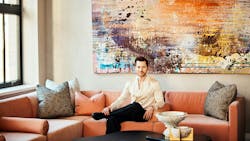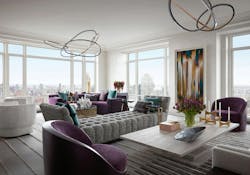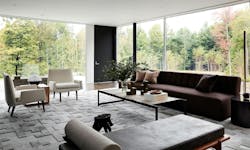Drake/Anderson Harmonizes Luxury and Sustainability with Transition to /AND Design
Just as New York design firm Drake/Anderson has celebrated its tenth anniversary, co-founder Caleb Anderson has assumed the role of sole principal. Carrie Meadows, i+s editor-in-chief, recently spoke with Anderson about how he plans to advance the firm’s sustainability initiatives in a way that aligns his passion for creating what supports clients while subverting their expectations of luxury design. In this way, Anderson says, the firm and the industry as a whole can demonstrate that sophisticated design can also be good for people, for the planet, and for business.
i+s: First off, congratulations on your role as sole principal at Drake/Anderson. I know the firm was founded in 2015 with Jamie Drake, so how exciting to see your new chapter begin in the tenth year! What does this step mean to you, and for the firm direction overall?
Caleb Anderson: Thank you so much. For background: This is the conclusion of a succession plan. What I’m stepping into, you’re meeting the beginning of what’s being birthed. This process and evolution is very important to me. We’re not abandoning who we were, but enhancing and evolving to meet this moment in the world to do work that is as beautiful as it has always been, but with a deeper meaning and purpose.
I have to acknowledge, I read that part of your mission [for i+s] is “Design with Purpose,” and, interestingly, with this announcement, I added a “purpose” tab to our website, speaking to the things that we want to do in our new framework. I thought that was an interesting alignment, that we’re both using that word, “purpose.”
i+s: Can you explain what the firm’s vision of “dynamic eclecticism” means, and how it incorporates that sense of purpose?
CA: I love this question. What that has meant is a design philosophy where we marry what are typically perceived as disparate things. For many years, I’ve loved combining different periods and different styles, but finding a way to bring harmony and develop a design language by connecting these pieces which you wouldn’t necessarily think to pull together. That creates really interesting, diverse, inspiring design.
There are different tactics or formulas that I’ve used over the years. Now you can take a beautiful antique bergère, for example, that has a lovely, curved arm, and then that’s referenced in a contemporary, minimalistic side table that has a similar curve. So when I say dynamic eclecticism, it’s really about bridging things that are unexpected, but doing it in a beautiful way. And as a person, I enjoy finding ways to bring harmony.
How would I apply that to the future of the “purposeful” framework that we mentioned? Incorporating more natural elements, more organic, biophilic elements, but then contrasting that with contemporary or futuristic clean design and finding ways to merge that into a design-forward aesthetic.
From a functionality standpoint, the idea is similar. Most of our clients are high-end residential and they have not necessarily been exposed to the breadth of sustainability, circularity, and healthy materials in luxury design. They may associate those things with more commercial design. For me, eclecticism is showing how this fine design can marry and live alongside these new, more purposeful initiatives and incorporate health, well-being, and circularity.
i+s: I imagine that some people would envision more dissonance between sustainable materials, style, and that feeling of sophistication. How will Drake/Anderson approach sustainability and circularity with that in mind?
CA: That’s the opportunity here for our firm—to demonstrate that’s not true. I should backtrack a little bit to tell you where all this is coming from for me. A few years ago, I was so stressed out; I was completely disconnected from my passion. What I came to learn was that a lot of designers were in a similar place. I started embracing wellness, yet something within me just couldn’t reconcile the work that I do with these values. So I put a lot of work into aligning and bringing congruency to these things. And this next chapter is, hopefully, a demonstration of these values that started from my own well-being and brought my attention to a larger issue that we have in this industry.
I took a class through the Parson Healthy Materials Lab on material help that really put me into action. One of the challenges that we have in the industry is trying not to just check boxes [regarding health and sustainability in design]. People may have an awareness of sustainability, but it’s not a driver. Clients are often driven by budget—even on high-end projects—and timing. Where in the conversation does material come into play? Or helping the planet, or social equity? I’m driven to merging all of these things as part of what we do, and it’s transparent. For the past couple of years we’ve been testing the waters, developing a framework, finding a way and a process that’s feasible for us to address sustainability, but it was optional. Now these are non-negotiable [factors] for us at this point.
We certainly do so much more virtually now than ever before. During COVID, of course, we adopted many new presentation standards that enabled us to do more virtually and waste less material. At one point previously, like with printing tearsheets and creating mood boards, everything was very paper oriented; we hardly do that at all now, which is great. Obviously the greatest benefit of that is environmental, but also it creates expediency and efficiency. Over time, we’ve been able to see that pay off in terms of more time for creative conversations, more time to focus on like-minded vendors, and so forth.
i+s: Would you say that passion, or a sense of connection, perhaps, is a challenge for the design industry? How does one connect the values you mentioned with opportunities for business growth?
CA: What we need as a community and as an industry is to foster and cultivate values that intrinsically connect us to why [design] matters. When you operate from that heart space, your business is more genuine because the embodiment of these values would then inform the work that [you] do.
A lot of us are working in a vacuum. To make meaningful impact, there needs to be a bit more synergy between the different facets of our industry—between the A&D community, manufacturers, media. I think media is huge because you craft the narrative that the consumer or the client starts with. You know their values, their needs, or their likes and dislikes. So I’m hoping to have opportunities to create new conversations among all these facets. In this type of design, we’ve typically worked in a competitive model, so how do we move into the space of collaboration and co-creation? From there, I think we can make more impact.
Also, designers at some point in their career can become disconnected from their unique gifts, because they’re concerned about getting this project or following this trend. I would love to foster that, getting people connected to their gifts and create that collaboration. That is a big shift that has to occur. Again, it’s not perfect. It’s not overnight. I understand that the impact that I can make with my firm is minimal, but I do believe that from an inspiration standpoint, it can trickle down and make meaningful change.
I’ve spent time working with a consultant on a feasible starting point, identifying what is realistic for us as a firm to step into this direction. We signed the AIA Material Pledge, and we’re one of the first luxury residential firms to do so. We use that common materials framework, which outlines health, circularity, climate, and social equity opportunities within all of these categories.
Take something like health. Any time we bring a material or a partner into the firm, we have a transparency vetting agreement. If they aren’t able to provide us with the required information, it at least starts a dialogue with them. For example, with Phillip Jeffries, which is a huge wall covering company, they created a healthier vinyl [background] because they didn’t have one that met our criteria.
We use no products that have Red List chemicals. This next year, for climate requirements, we’re trying to achieve 40% of our specs coming within an 800 mile radius. These ideas support the industry, especially with smaller firms, giving them something to work with that is not overwhelming. I’m hoping we give something tangible for people to understand and say, “Look, here’s what we did, and how can you apply this to your firm?”
We have a healthy materials library where we catalog the different materials we brokered. We’ve worked with a custom upholstery workroom for many years. We’ll now go to them and ask, “Can you construct the sofa this way and not put this [material] in there, and put this in there instead?” Again, we’re connecting to that ecosystem and seeing how, when we start to do our part, we’re elevating our partners.
What has become very apparent to me is that I have to do my part and have integrity with myself and what we are doing. That’s re-energizing. I really think the next creative opportunity for our industry is bridging purpose with beautiful and inspiring design.
Hot Takes
Favorite interior project: There is a biophilic project—a Phillip Johnson-esque glass house in the middle of nature. It was such a different project for us because the natural environment informed the design and the process, because of all the windows. Again, it represents that harmony between the designed environment and the natural world outdoors. The house is this living, breathing thing because your experience in the home changed with the external environment, the seasons, the entire color palette changed. It was very dynamic.
A design trend or feature you’d like to see disappear: This is probably a cliche response, but again just this idea of trend. I honestly don’t really follow aesthetic trends. I do in the sense of technological advancement or innovative materials and those things. But I like design that feels timeless. I think people get sidetracked by the trend conversation in that it can imply something that’s fleeting. And I want things that are timeless, that have permanence, like heirlooms.
One kind of mass consumer trend that I wish would go away is LVT because it’s toxic. But it’s installed all over the place.
A project “fail” or an issue early in your career: A broader thing earlier in my career—I was such a people pleaser. Now I’m all about aligning expectations. With the maturing that has occurred over the course of my career, I’ve become more straightforward—even if that means telling clients something that they don’t want to hear—and it’s much better.
A design feature or principle that is underappreciated: From the residential perspective, the objects, the art, the styling, the personal effects—it’s not something that many clients are initially interested in. They’re thinking about the furniture or the rugs, and so on. That final layer, though, it’s like the jewelry. The personal effects and the storytelling are so critical. That’s not necessarily design principle, but I think that it is an aspect of our work that is not always prioritized. It feels like something’s missing when you don’t add those layers and you don’t incorporate things that feel personal. The same applies to cultural references that hold meaning to the client and can also hold the design together when they’re considered.
i+s: How does all of this tie into the /AND Design movement that was mentioned in your firm’s January announcement?
CA: /AND Design is all of these things I’ve talked about. When I chose the name, it was this intentional distilling of our current brand. The logo is Drake/Anderson and I’ve essentially erased everything but slash “And.” It’s symbolic to me. I worked with a publicist who was a very good friend. When I was working through this process in the early stages, she gave me this idea for this name. She passed away not that long after, so it’s a beautiful gift that she left me.
I’m trying to move away from personality based design into this more collaborative endeavor—I mean beyond the walls of our office. I don’t know what it’s going to end up looking like, but I do know it feels very right to me. I would like to think it is a movement in the sense that it’s not within the current paradigm. I’m not concerned with a lot of the things that historically have concerned me anymore. I may set a vision or give some leadership, but it’s really the whole spectrum of everyone who is a part of this journey and it’s an acknowledgement of that.
There is a sense of vulnerability in stepping out in this way. But that’s okay. For me, personally, that’s a growing edge. Imagine as an industry, if enough people were really in that space, how that would give pause and give us a moment to assess and find impactful ways to move forward.
The other thing that’s evolving for me is trying to orient clients in what they’ve hired us for and what they want the outcome of their project to be. So many times clients come to us with pictures, saying, “I want this,” and they are very concerned with trends. A more creative process allows me to work with the essence of the client and what they truly need and what will support them. Yes, it will be beautifully designed. And maybe these images are a point of inspiration, but their primary motivation for creating an environment comes from that place of understanding what supports the essence of who they are—not what’s on page 36 of whatever magazine.
About the Author
Carrie Meadows
Editor-in-Chief
Carrie Meadows is Editor-in-Chief of interiors+sources (i+s), where she leads editorial strategy, content development, and brand storytelling focused on the people, projects, and innovations shaping the design industry. With more than two decades of experience in B2B media, she has built a career connecting technical expertise with creative insight—translating complex topics into meaningful stories for professional audiences. Before joining i+s in 2024, Carrie served as Editor-in-Chief of LEDs Magazine within Endeavor Business Media’s Digital Infrastructure & Lighting Group, guiding coverage of emerging lighting technologies, sustainability, and human-centric design. Her earlier editorial experience spans across Laser Focus World, Vision Systems Design, Lightwave, and CleanRooms, where she managed print and digital publications serving the optics, photonics, and semiconductor sectors.
An advocate for clear communication and thoughtful storytelling, Carrie combines her editorial management, SEO, and content strategy expertise to help brands and readers stay informed in a rapidly evolving media landscape. When she’s not crafting content, Carrie can be found volunteering at a local animal shelter, diving into a good crime novel, or spending time outdoors with family, friends, and her favorite four-legged friends.



